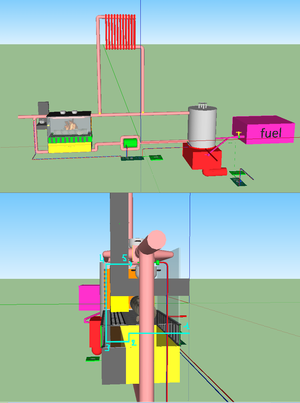
The space heating system is one of the largest GHG-emitting sources we have in our house. In order to reduce the amount of GHG emitted, aswell as increase the efficiency of the system/reduce operating cost, there are several modifications we can do, depending on the type of space heating system you currently have/use.
Central heating systems[edit | edit source]
If you use radiators heated by a burner operating on fossil fuel, you can:
- change the fuel you use (ie natural gas, fuel oil,...) to a biofuel (ie straight vegetable oil,...)
- use your existing fireplace, or implement a new fireplace/stove (which burns wood) to heat your radiators. This can be done using a heat exchanger. This is a cost-effective option (wood being cheap) which reduces your emissions considerably. The downside however is that you need to start your fire manually every time. You also can not use your old fuel-powered heater.
- use the heat from the ground, groundwater or outdoor air to heat your house.
- replace the fuel-powered heater with a electrical heater. This is economically the least intresting option, yet reduces GHG emissions of this appliance to 0[1]
Using reflectors[edit | edit source]
Radiator reflectors can be made and placed behind your radiators and the walls. They can be made DIY from sticking aluminium kitchen foil unto pieces of cardboard. The reflectors improve the efficiency of your radiators greatly as they avoid that any heat generated goes into the walls. Perhaps surprisingly, heat that goes into the inner or outer brick walls of your house is lost and does not contribute to heating the house (unlike e.g. with glass bottle walls, which do radiate this heat back).
References and footnotes[edit | edit source]
- ↑ Atleast when using "green power" from the electricity companies